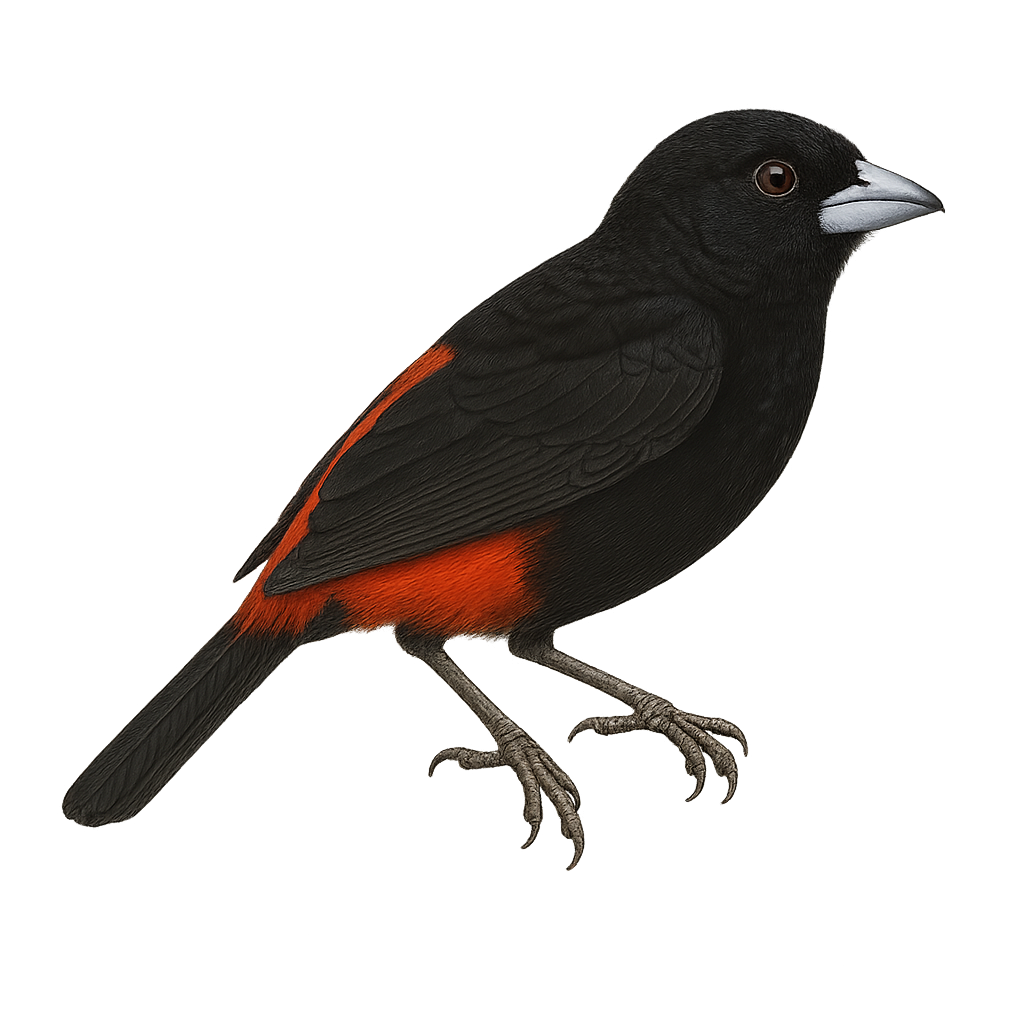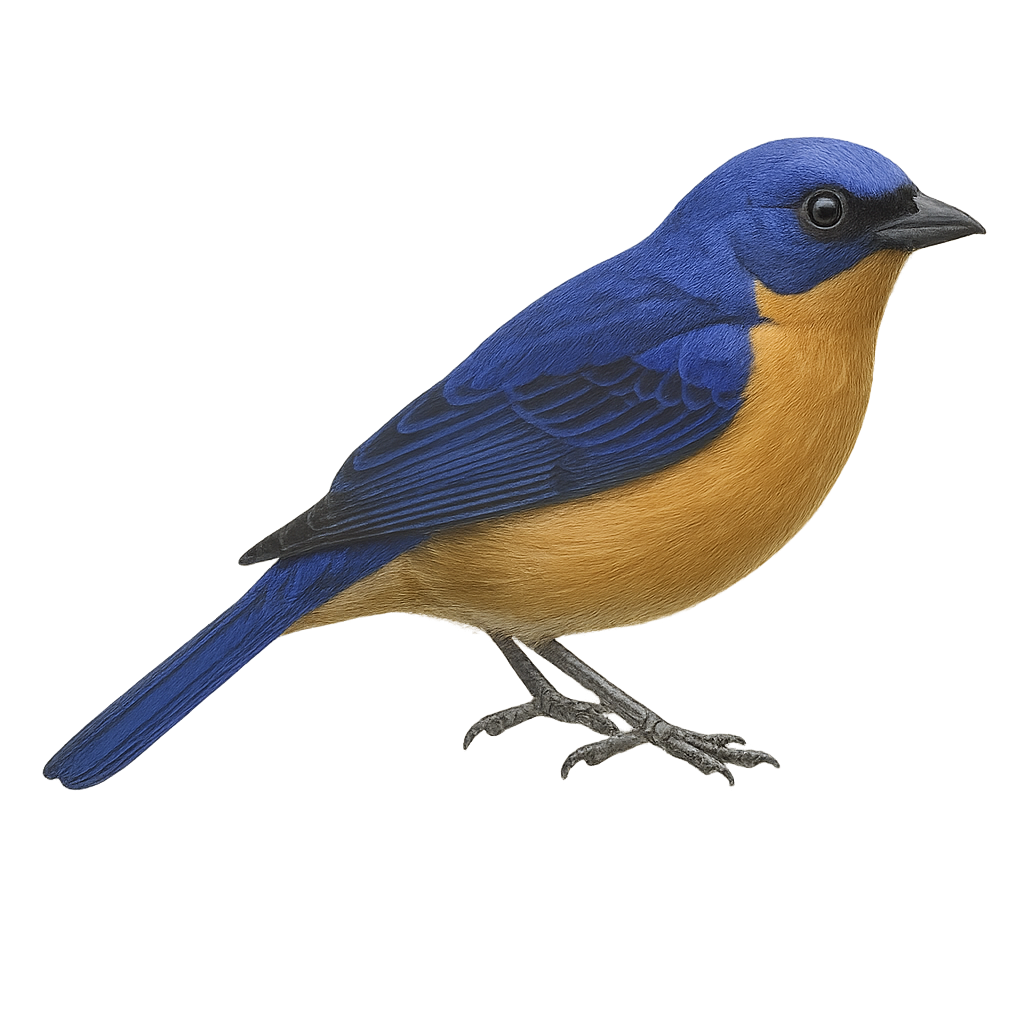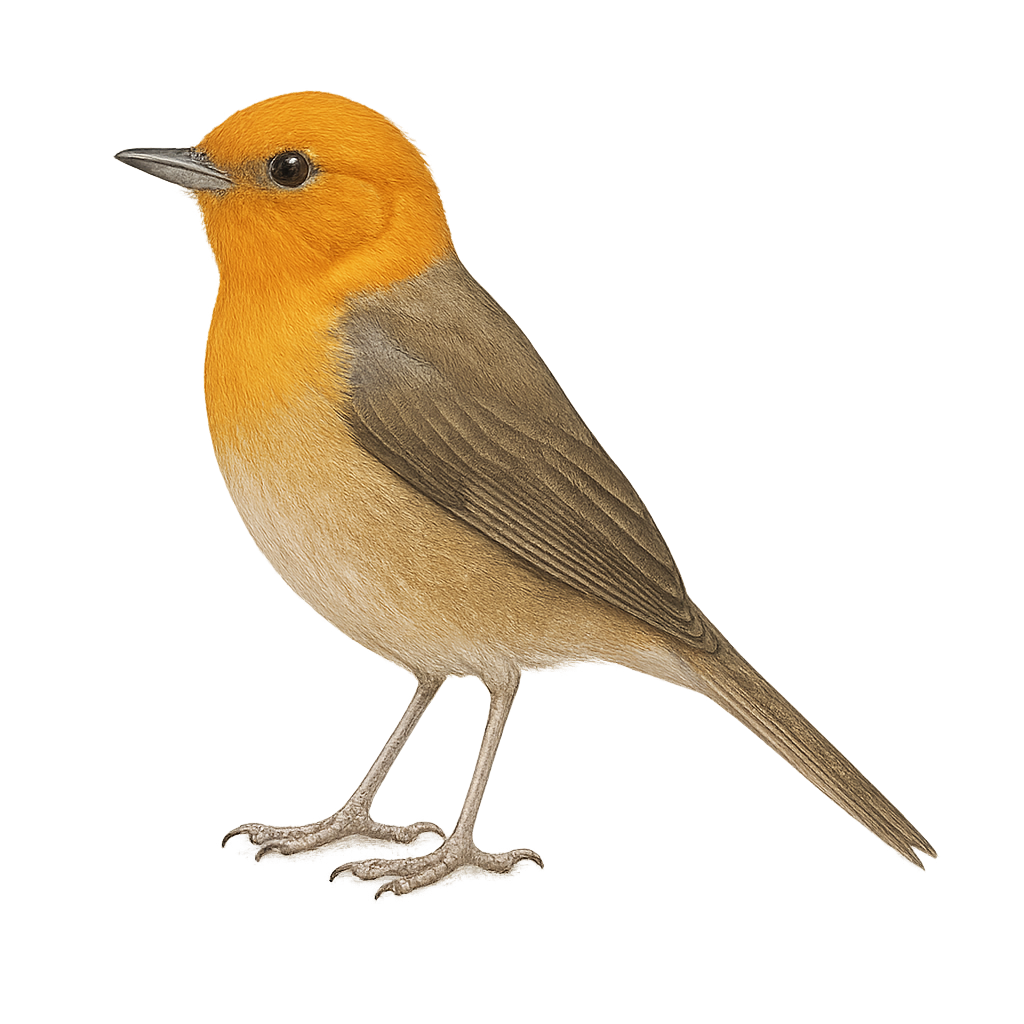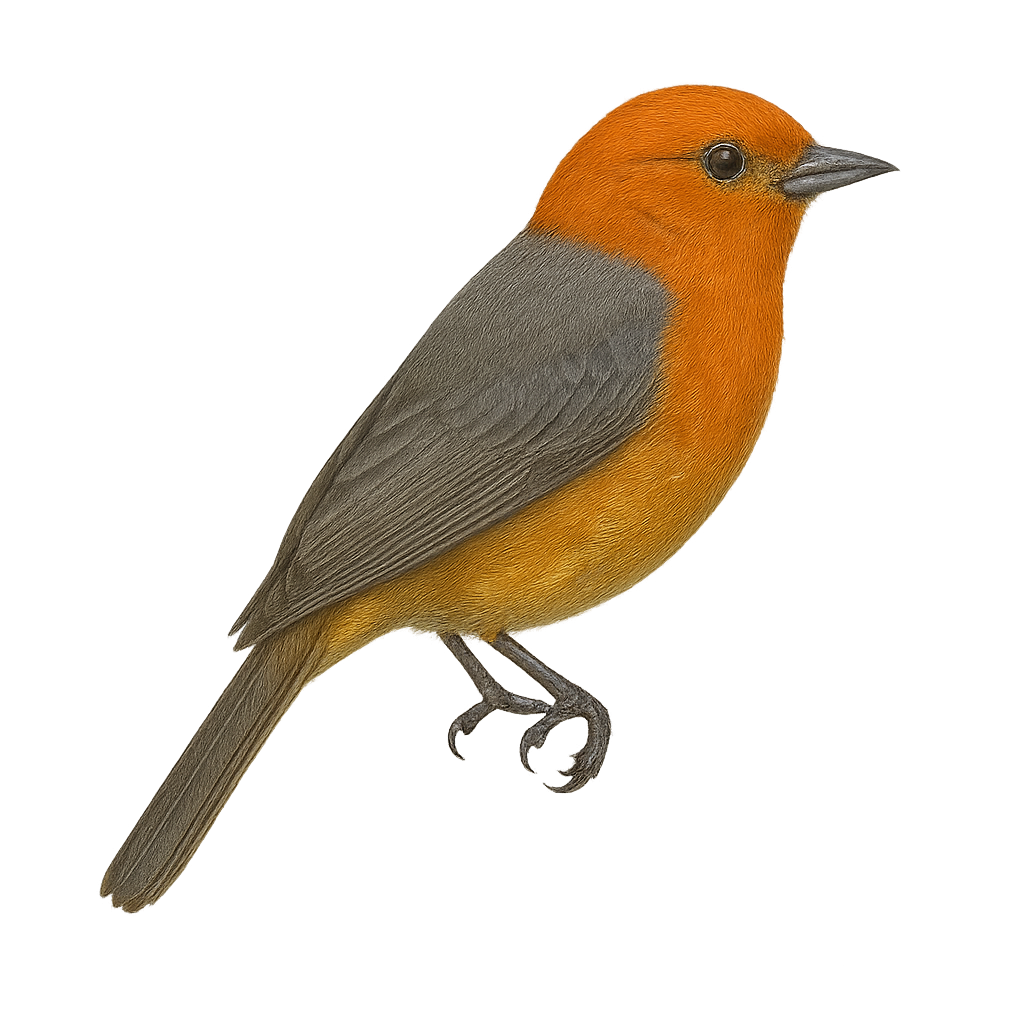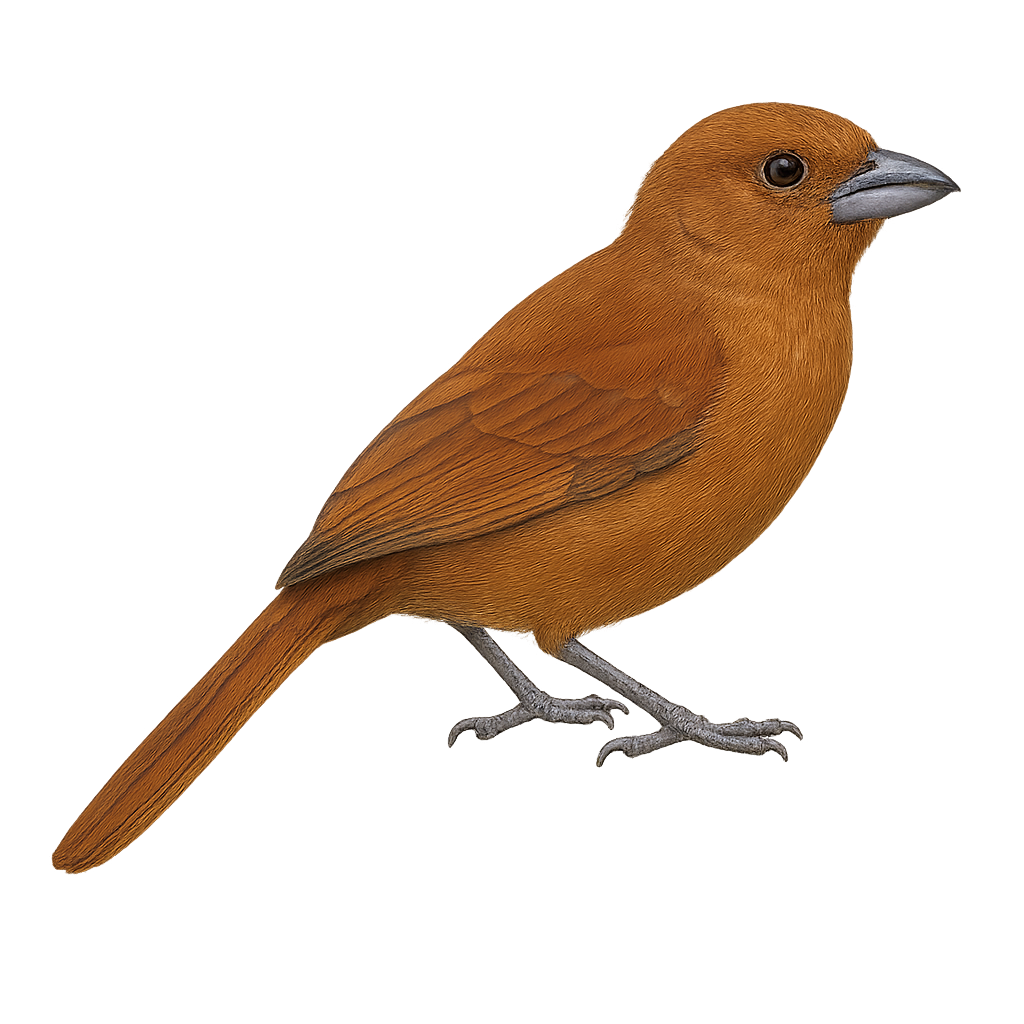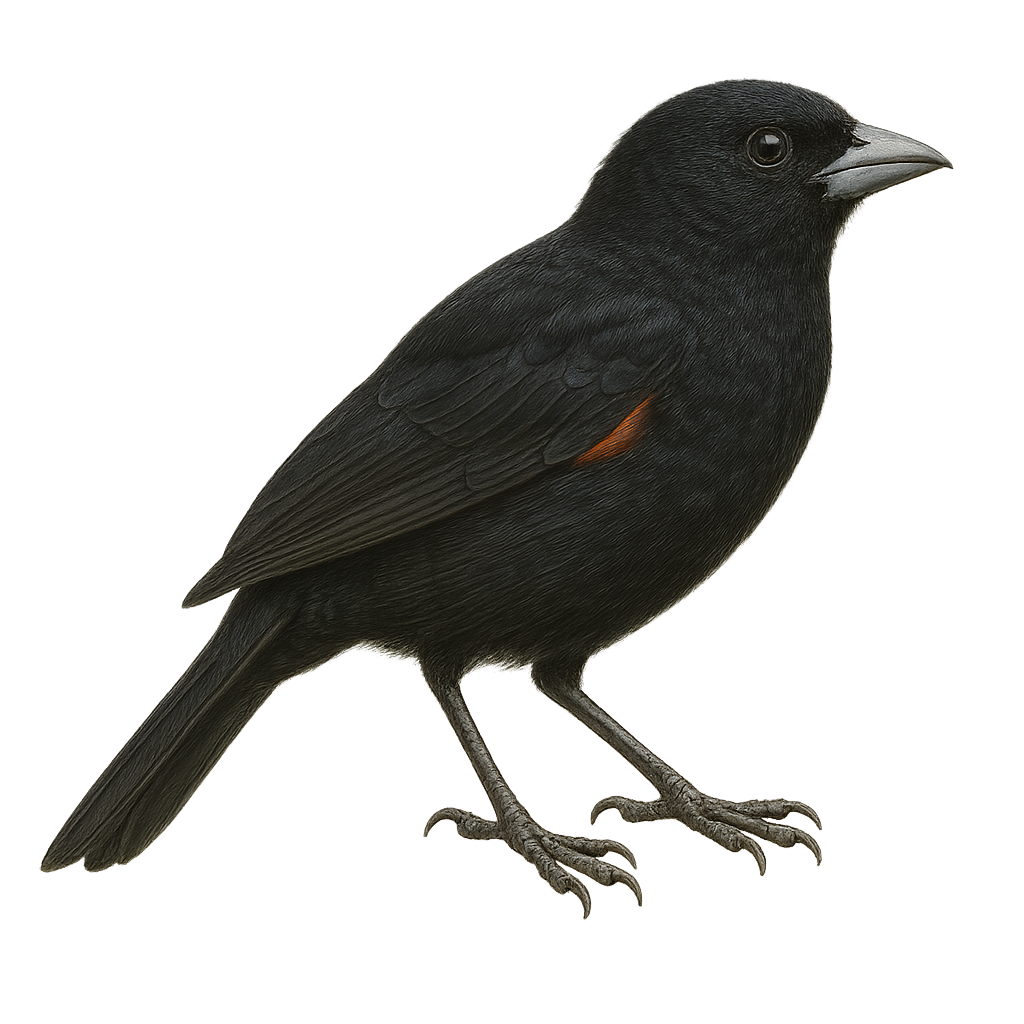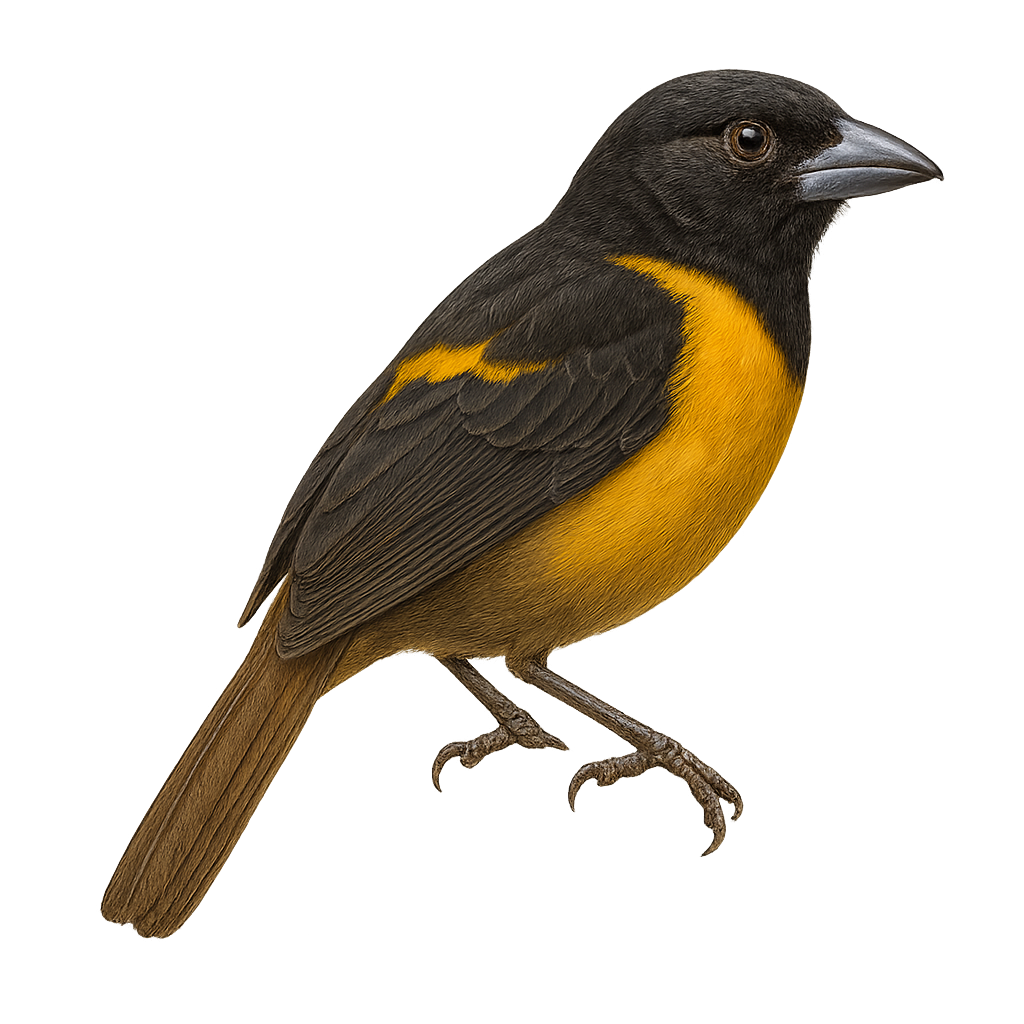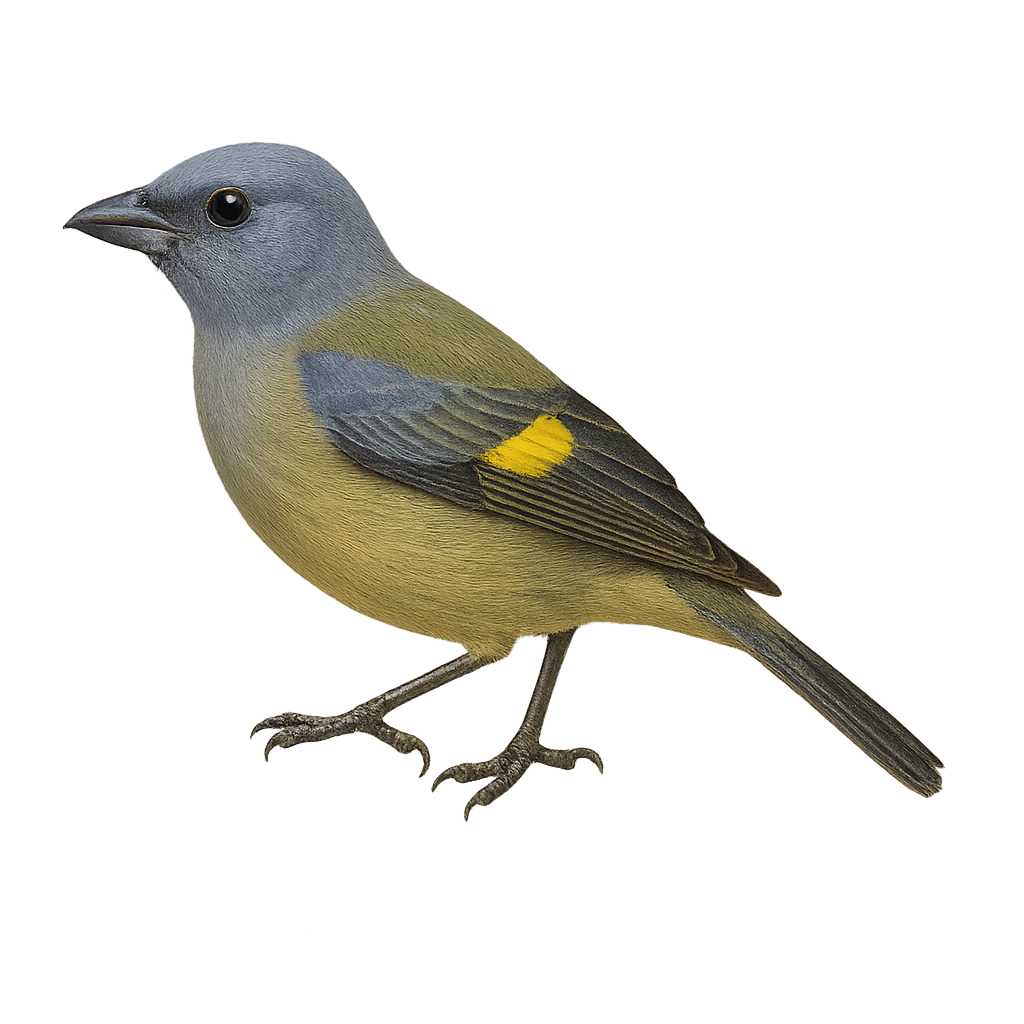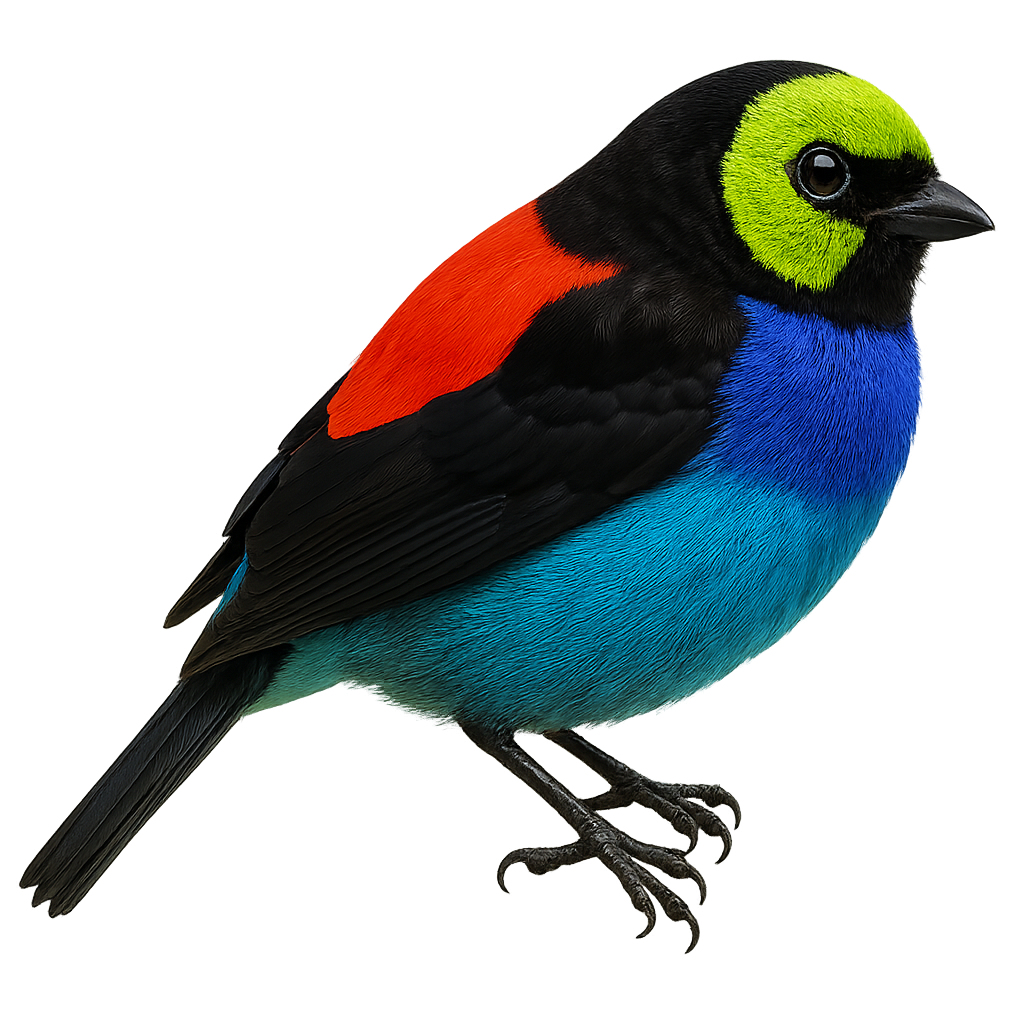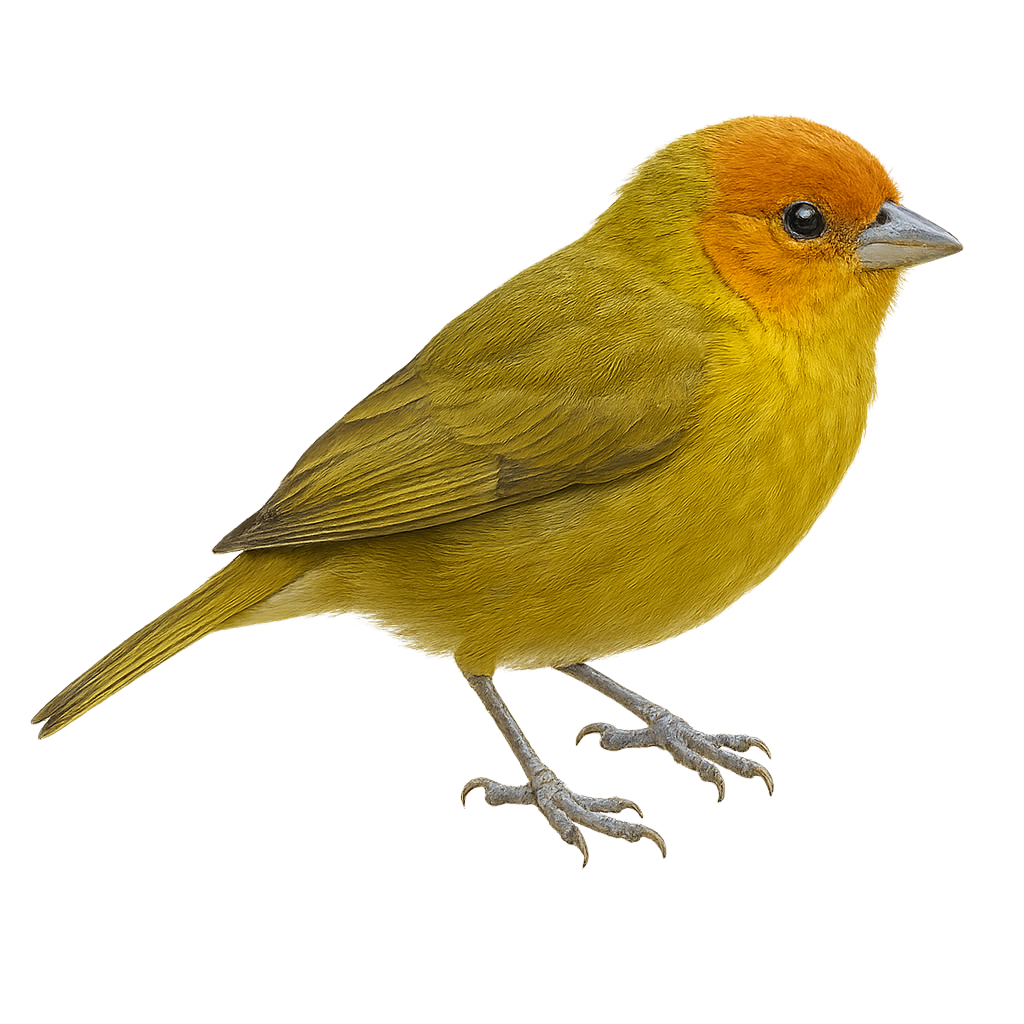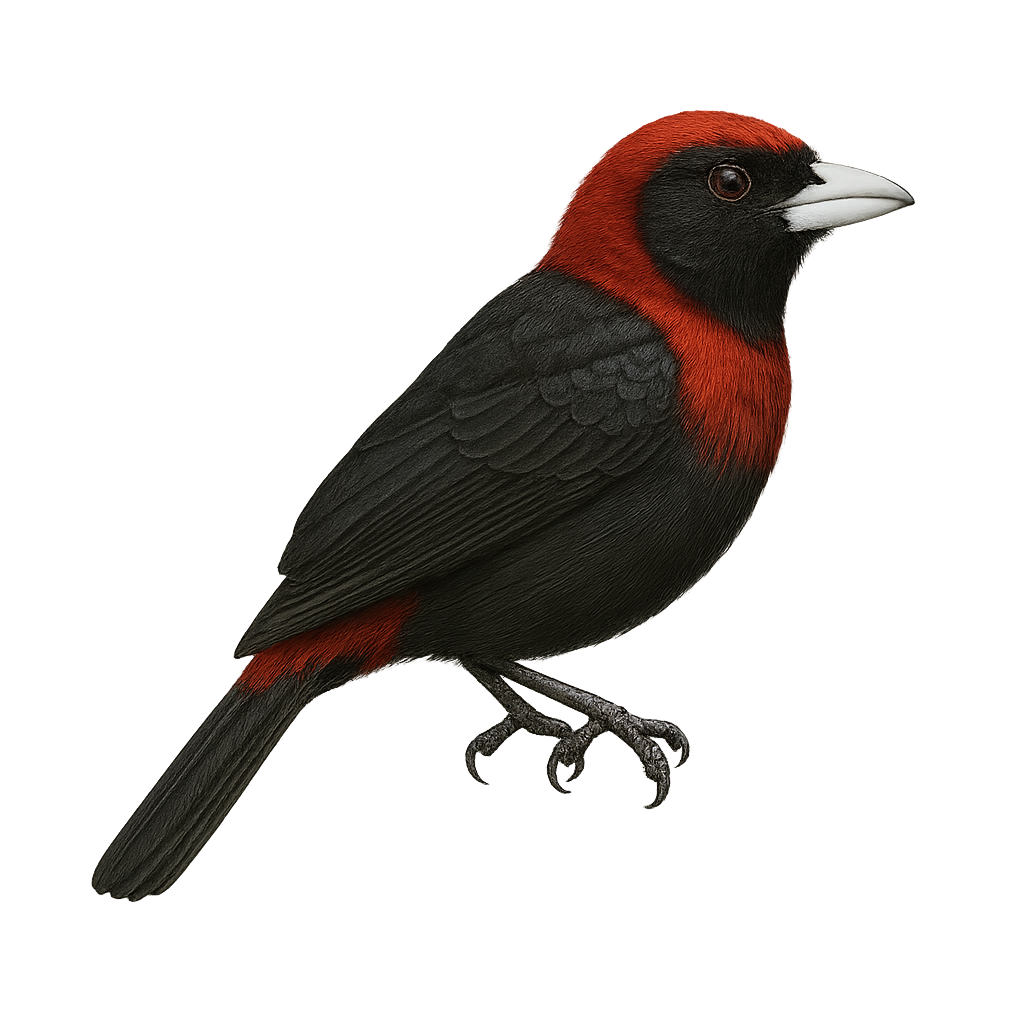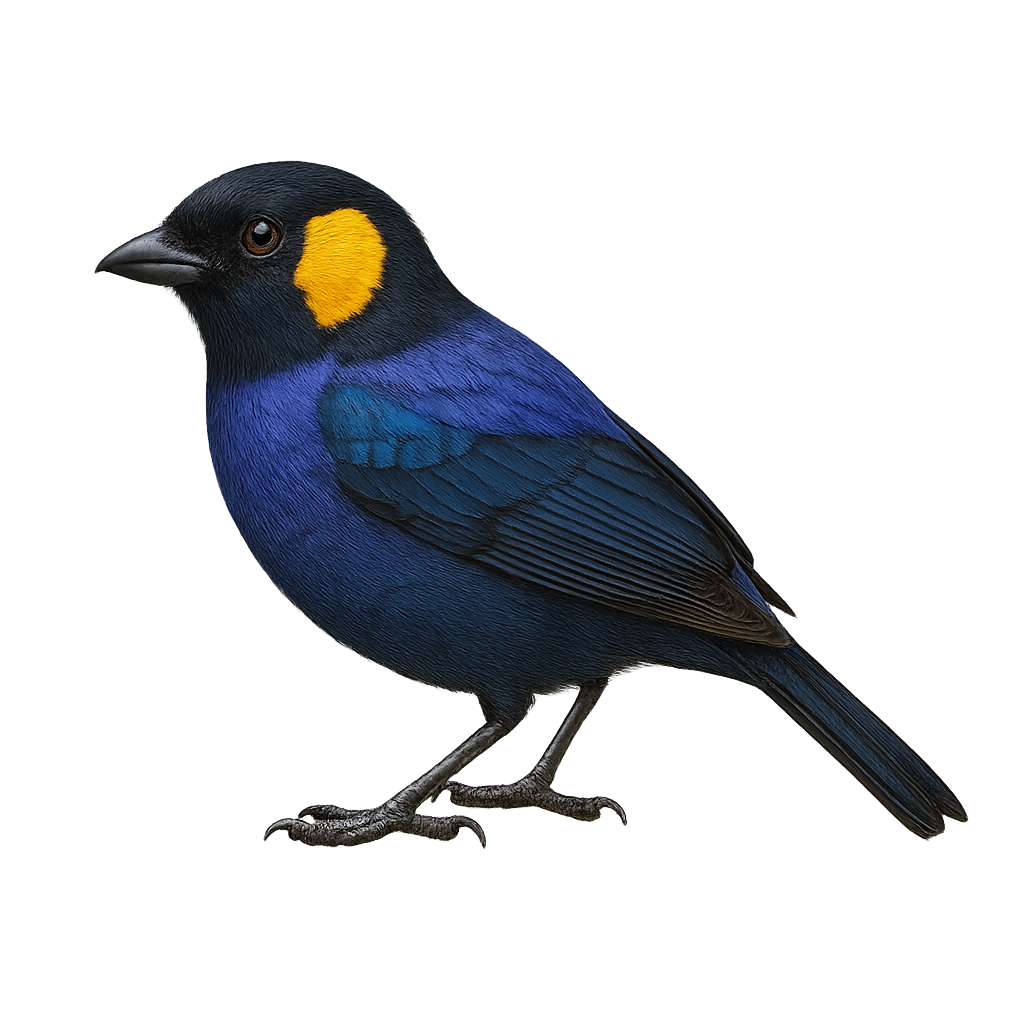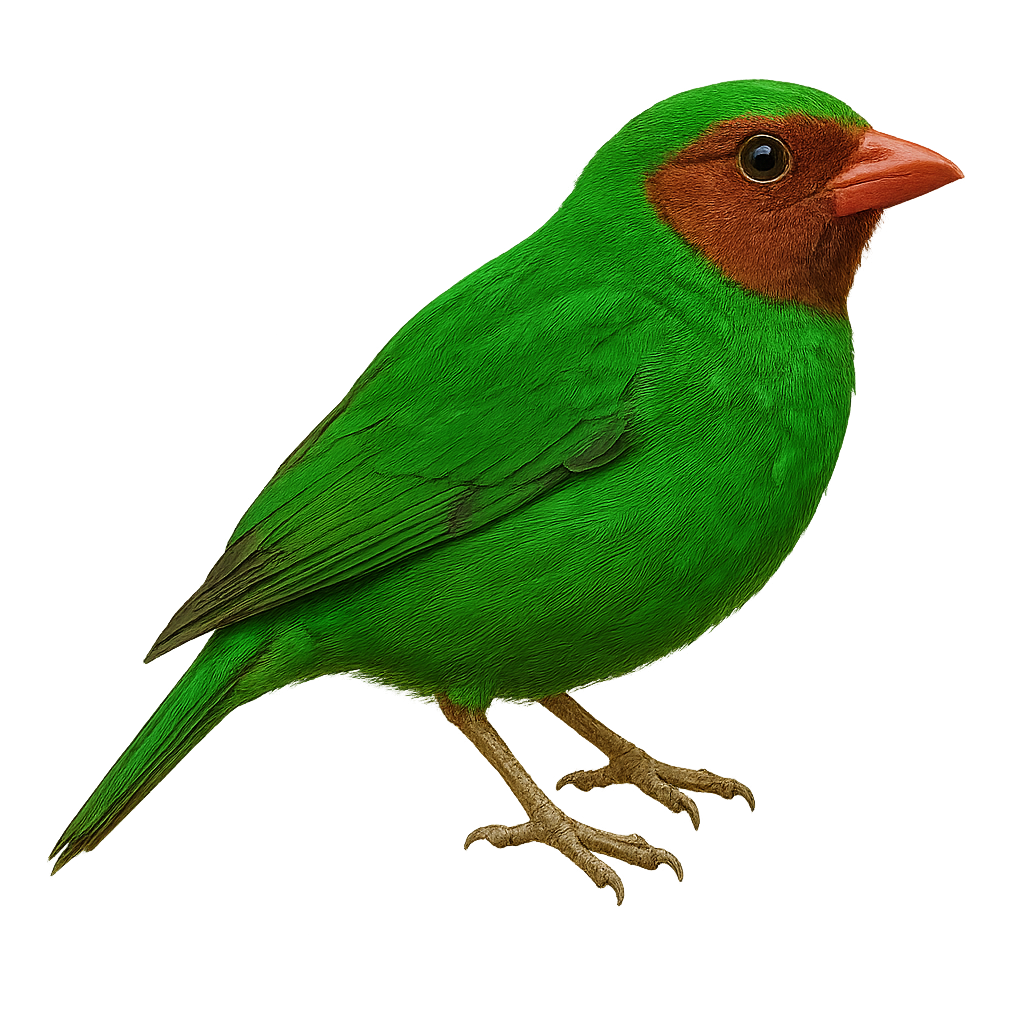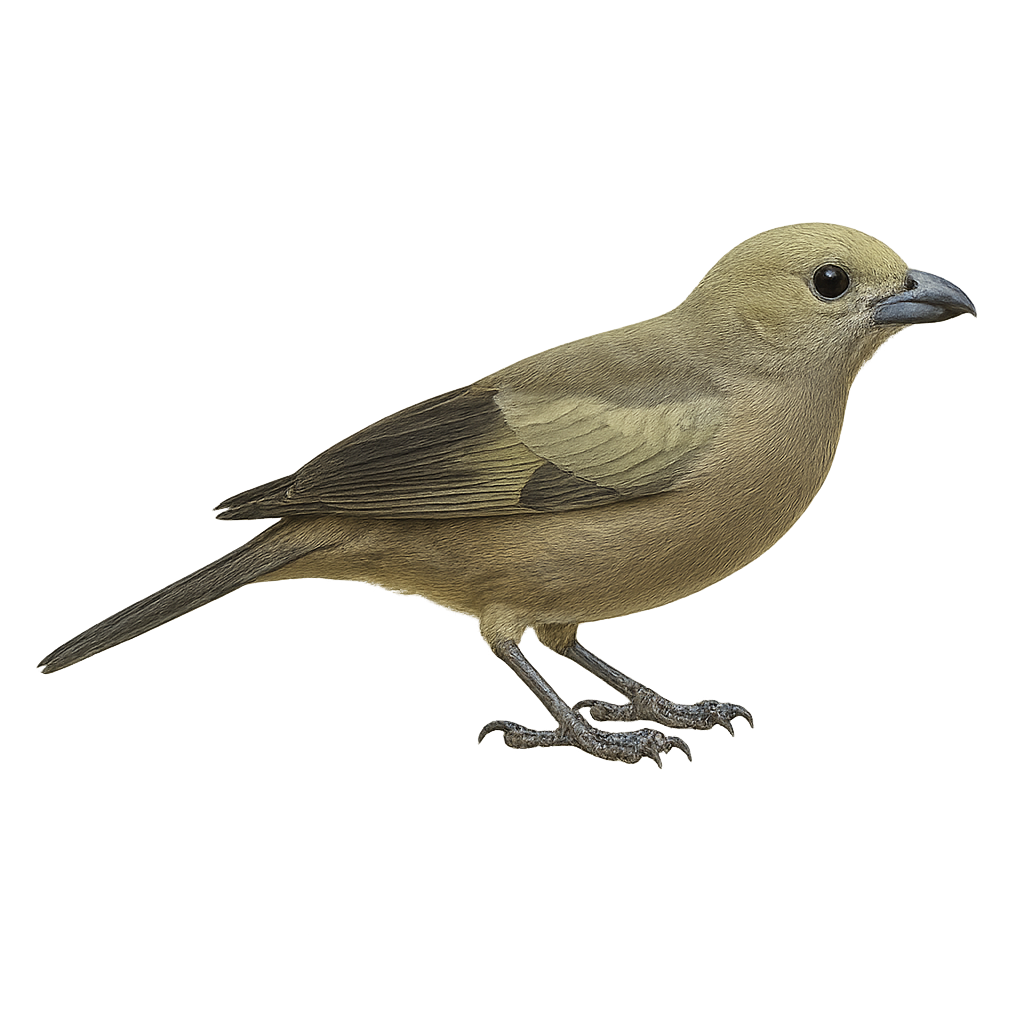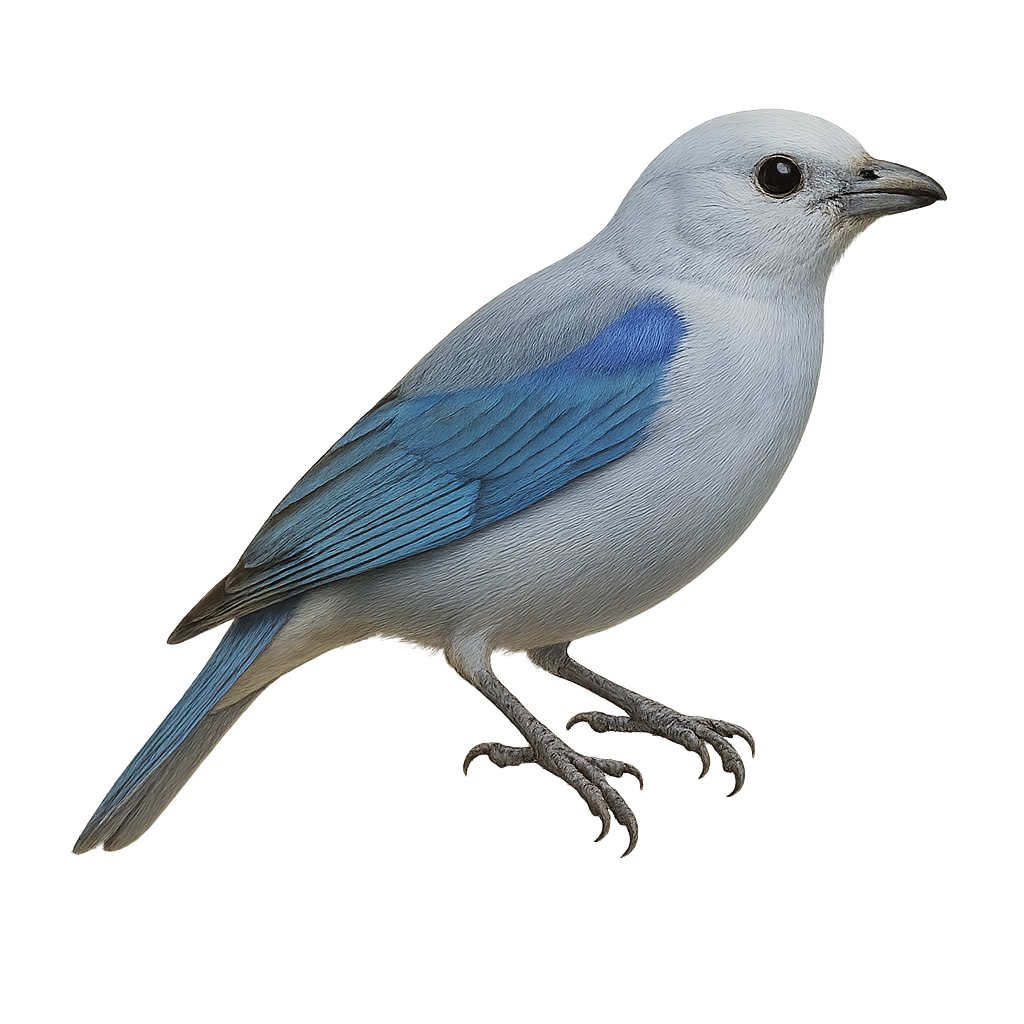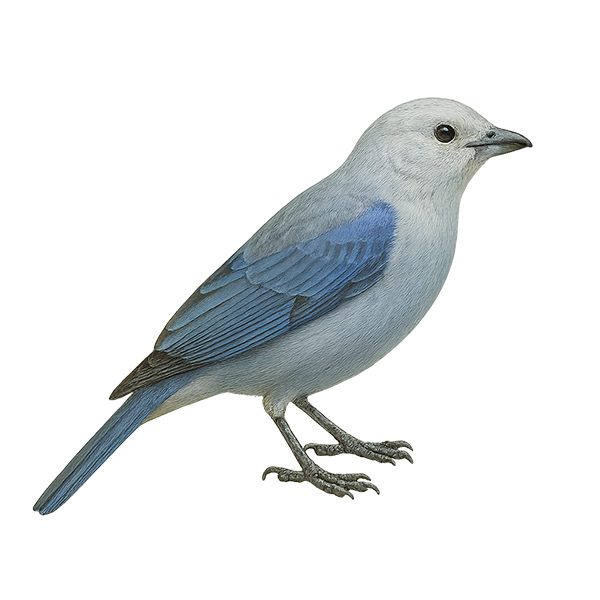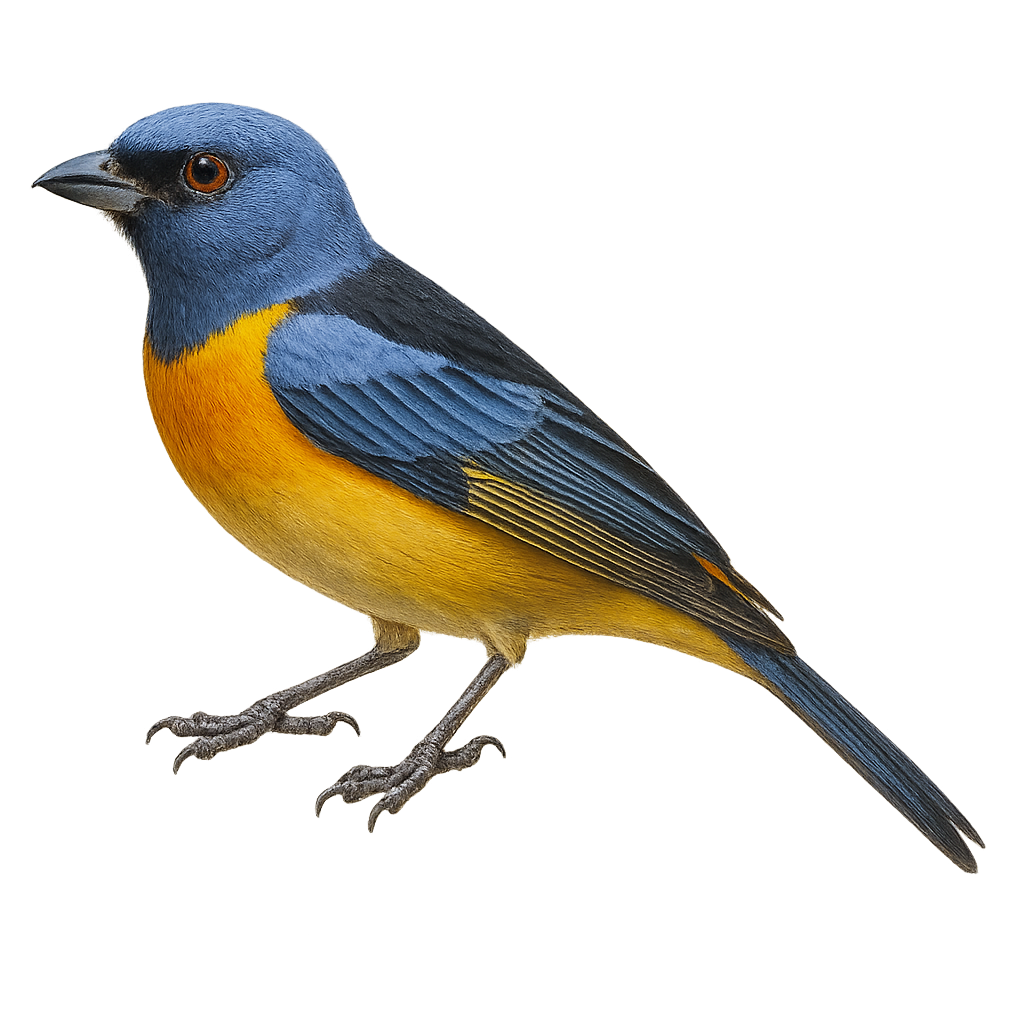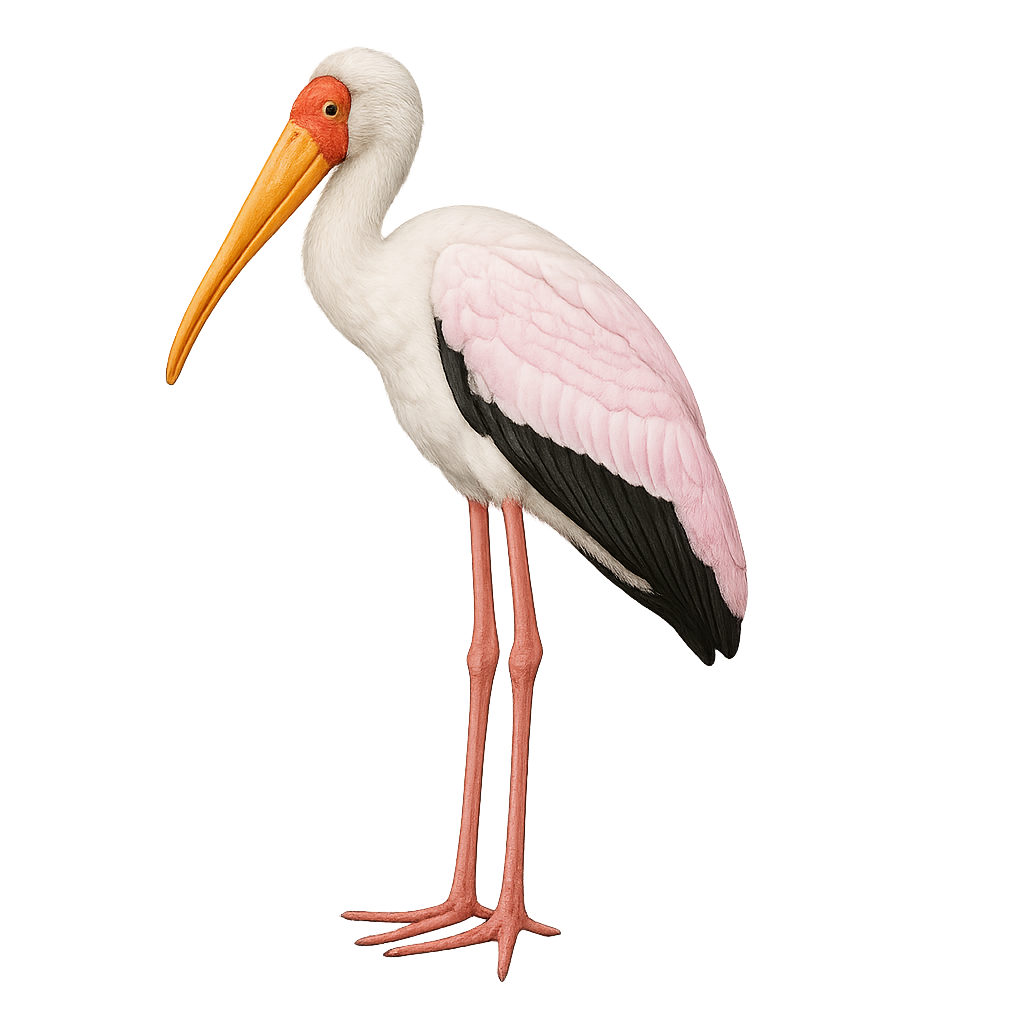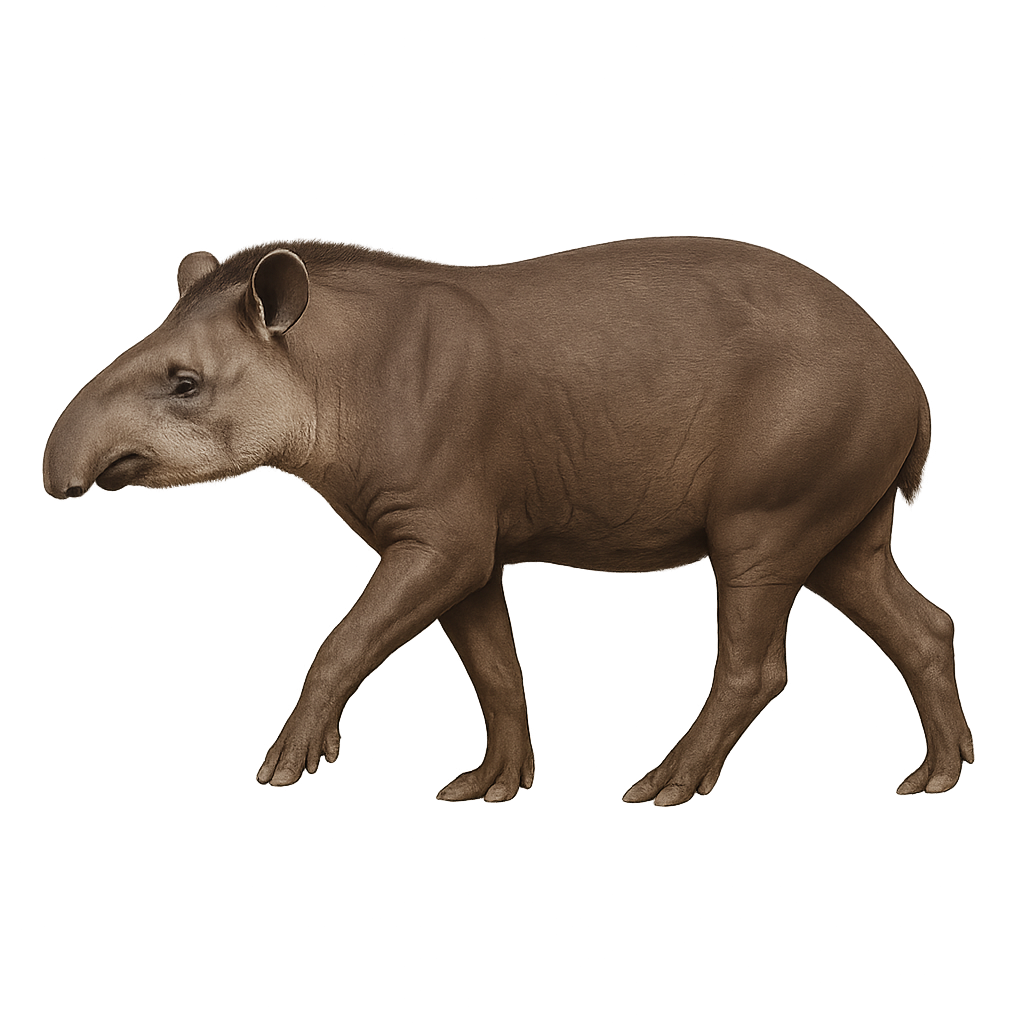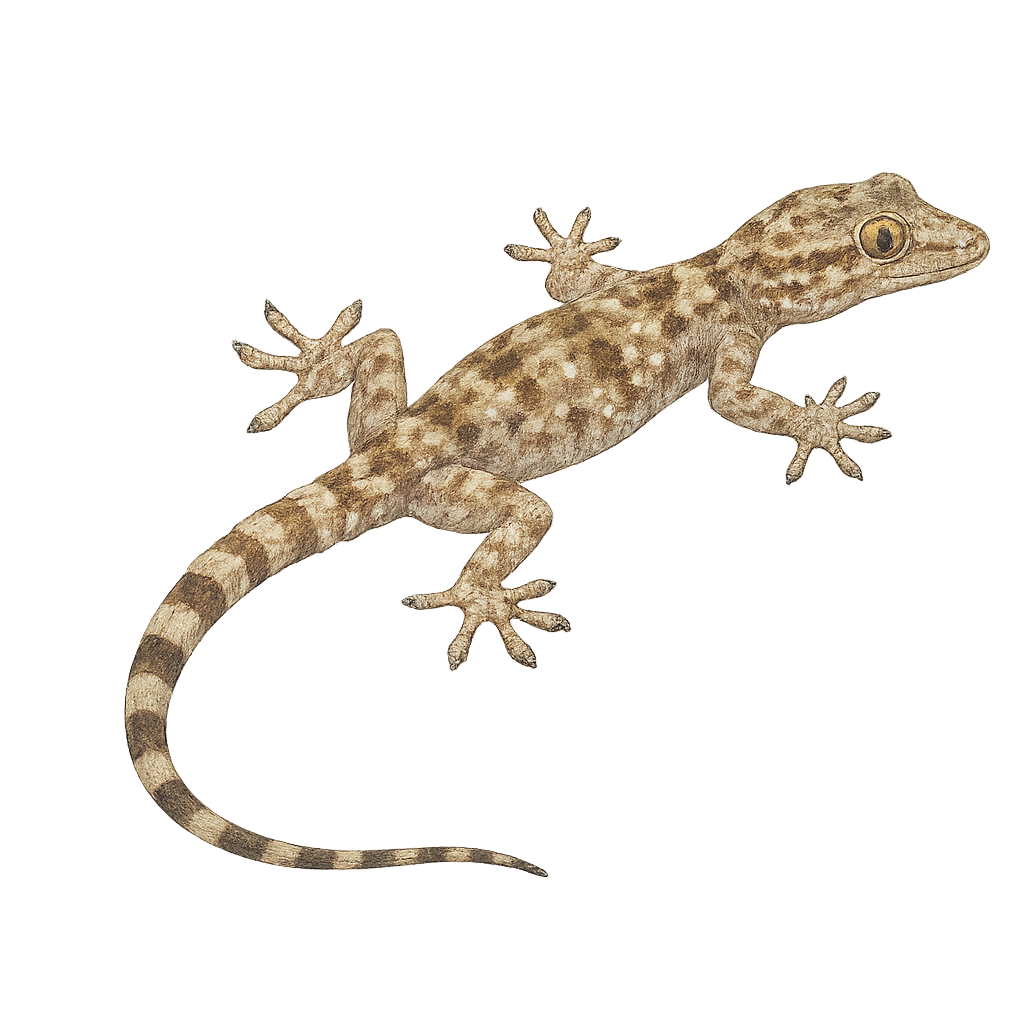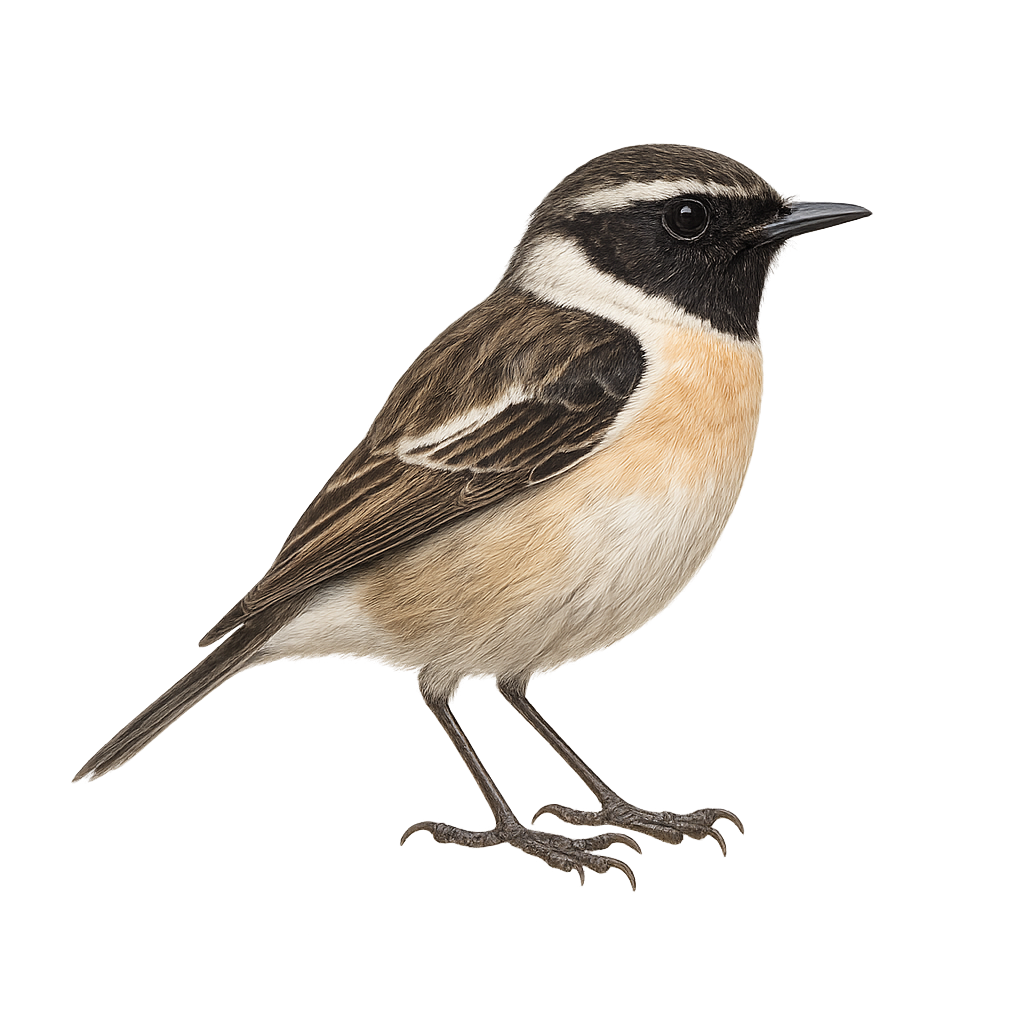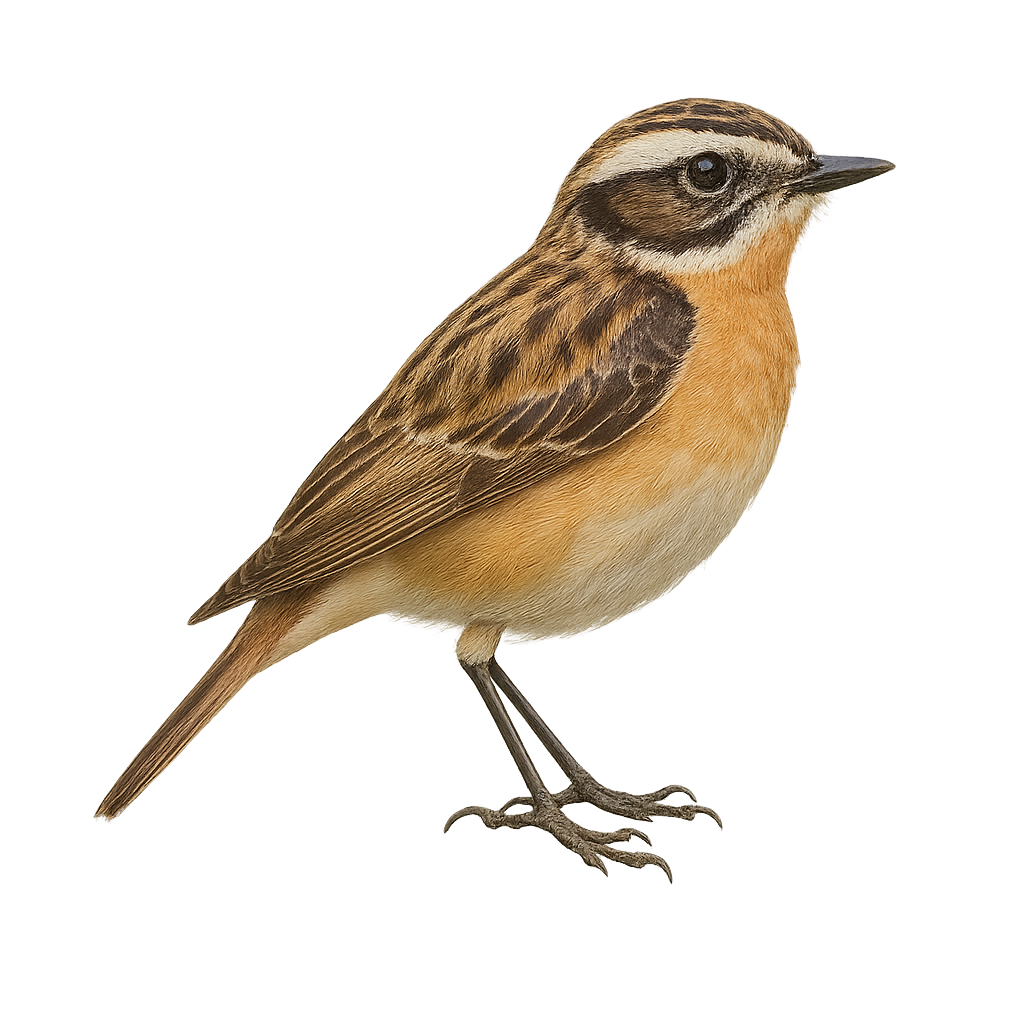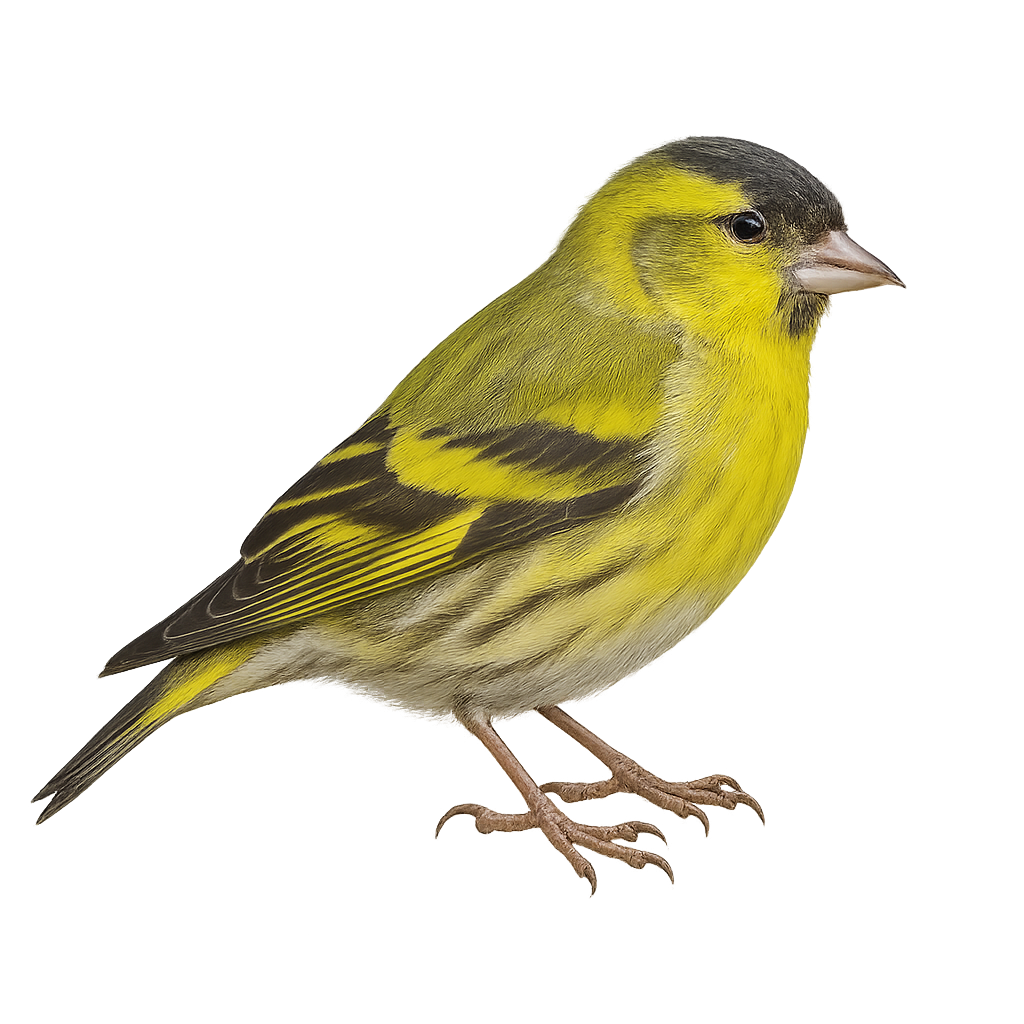The Passerini's Tanager, or Ramphocelus passerinii, is a colorful and fascinating bird found mainly in Central America, particularly in Costa Rica and Panama. This bird features a glossy black plumage with a bright red back, making it easily recognizable. Males and females show slight differences in coloration, with females having duller shades. They typically inhabit tropical rainforests, forest edges, and plantations, where they primarily feed on fruits and insects. Their song is soft and melodious, often heard at dawn. Although they are relatively tolerant of human presence, they prefer habitats with dense vegetation.
The Fawn-breasted Tanager, or Pipraeidea melanonota, is a colorful bird belonging to the Thraupidae family. It is recognized for its vibrant plumage, featuring a black back contrasting with a bright yellow belly and shades of blue on its wings and head. This bird is mainly found in the mountainous regions of South America, particularly in Argentina, Brazil, and Paraguay. It inhabits humid forests, forest edges, and shrublands. The Fawn-breasted Tanager is a diurnal, active, and sociable bird, often seen in small groups. Its diet primarily consists of fruits, nectar, and insects. Although not considered threatened, deforestation and habitat loss can impact its local populations.
The Rufous-chested Tanager, Thlypopsis pectoralis, is a bird from the Thraupidae family. It is mainly found in the mountainous regions of western South America, particularly in Peru and Bolivia. This bird is distinguished by its characteristic rufous chest, contrasting with its gray back and dark wings. It inhabits humid forests and shrublands at altitudes ranging from 1000 to 3000 meters. The Rufous-chested Tanager is a diurnal bird, often seen in small groups or pairs. Its melodious song and vibrant colors make it a favorite among birdwatchers and photographers. Although its conservation status is currently "least concern," deforestation could threaten its habitat in the future.
The Rufous-chested Tanager, or Thlypopsis ornata, is a small, colorful bird belonging to the Thraupidae family. It is primarily found in the mountainous regions of South America, particularly in Colombia, Ecuador, and Peru. This bird is notable for its vibrant plumage, featuring a rufous chest and wings with shades of gray and brown. It mainly inhabits humid forests and wooded areas, often at altitudes between 1500 and 3000 meters. The Rufous-chested Tanager is a diurnal bird, active mainly during the day, and feeds primarily on insects and fruits. Although generally suspicious, it can sometimes be seen in small groups.
The Ruby-crowned Tanager, or Tachyphonus rufus, is a medium-sized bird, about 18 cm long. It is easily recognizable by its glossy black plumage in males, with a bright red patch on the back, while females have duller, often brownish tones. This bird is primarily frugivorous but also feeds on insects. It is found in humid tropical forests, forest edges, and sometimes in gardens. It is widespread in South America, notably in Brazil, Argentina, and Paraguay. The Ruby-crowned Tanager is a sociable bird, often seen in small groups or pairs. Its song is melodious, composed of clear and repetitive notes.
The Red-crowned Ant-Tanager, Tachyphonus phoenicius, is a medium-sized bird known for its striking red head contrasting with its brownish body. It primarily inhabits the humid tropical forests of Central and South America. Often seen in small groups, this bird feeds on insects and fruits. Its melodious song and vibrant colors make it a favorite among birdwatchers. Although relatively common, its population is threatened by deforestation. Preserving its natural habitat is crucial for its survival. The Red-crowned Ant-Tanager plays a vital role in seed dispersal, contributing to the health of forest ecosystems.
The Orange-backed Tanager, Lanio aurantius, is a colorful and captivating bird native to the tropical forests of Central America. It is easily recognizable by its bright orange back contrasting with the rest of its black body. This bird measures about 18 cm in length and primarily feeds on fruits, insects, and small invertebrates. It usually lives in small groups or pairs, often in the company of other tanager species. The Orange-backed Tanager is an active and vocal bird, emitting a variety of songs and calls to communicate with its peers. Although its habitat is threatened by deforestation, it remains relatively common in some areas.
The Yellow-winged Tanager, or Thraupis abbas, is a colorful and fascinating bird found primarily in the tropical and subtropical forests of Central America. This medium-sized passerine boasts a striking plumage, with distinctive yellow wings contrasting against its blue-gray body. Males and females exhibit little sexual dimorphism, although males are often slightly more vibrant. The Yellow-winged Tanager is a sociable bird, often seen in small groups, feeding mainly on fruits but also on insects. Its melodious and varied song is a delight for birdwatchers. Although relatively common in its natural habitat, it is essential to preserve the forests where it resides to ensure its long-term survival.
The Paradise Tanager, known for its vibrant plumage, is a fascinating bird from the tropical forests of South America. Its head is a bright green, contrasting with a turquoise blue body and black wings. It measures about 13 to 15 cm in length and weighs between 15 and 20 grams. This bird primarily feeds on fruits, insects, and nectar, playing a crucial role in pollination and seed dispersal. It lives in social groups and is often seen in the company of other tanager species. Its song is melodious, composed of varied and pleasant notes. Although its habitat is threatened by deforestation, it is still widely distributed and not considered endangered.
The Rufous-capped Warbler, or Thlypopsis ruficeps, is a small, colorful bird primarily found in the humid forests and wooded areas of South America. Its distinctly rufous head contrasts with its more neutral-toned body, making it a captivating sight for birdwatchers. Often seen in small groups, it moves nimbly through foliage in search of insects and fruits. Although discreet, its melodious song often betrays its presence. This tanager is a perfect example of birds adapting to specific ecological niches, using its plumage for camouflage while exploiting available food resources in its habitat.
The Crimson-collared Tanager, scientifically known as Ramphocelus sanguinolentus, is a striking bird found primarily in Central America, particularly in Mexico, Honduras, and Costa Rica. This bird is noted for its vibrant plumage, featuring a bright red back contrasted with its black head and wings. Measuring about 19 cm in length, it is often spotted in tropical rainforests and wooded areas. Its diet mainly consists of fruits, berries, and insects. The Crimson-collared Tanager is a sociable bird, often seen in small groups or pairs. Although not considered threatened, deforestation poses a potential threat to its natural habitat.
The Edwards's Tanager, scientifically known as Bangsia edwardsi, is a vibrant and captivating bird native to the humid montane forests of Colombia and Ecuador. This medium-sized passerine boasts a striking plumage with shades of blue and green that catch the eye. Often seen in small groups, it primarily feeds on fruits and insects. Its natural habitat ranges from 1,200 to 2,400 meters in altitude, where it plays a crucial role in seed dispersal, aiding forest regeneration. Although its conservation status is concerning, efforts are underway to protect its habitat and ensure its long-term survival.
The Reinhardt's Tanager is a colorful bird belonging to the Thraupidae family. It is mainly found in the humid montane forests of South America, particularly in Colombia and Ecuador. This bird is distinguished by its vibrant plumage, featuring shades of blue, yellow, and black. It is often seen in small groups, feeding on fruits and insects. Although its habitat is relatively stable, deforestation poses a potential threat to its population. Reinhardt's Tanager is a fascinating bird for ornithologists and nature enthusiasts, thanks to its striking colors and social behavior.
The Grass-green Tanager, or Chlorornis riefferii, is a vibrant and fascinating bird primarily found in the humid forests of the Andes. With its bright green plumage, it is distinguished by a reddish head and a robust beak. This bird measures about 20 cm in length and feeds mainly on fruits, insects, and nectar. It is often seen in small groups, moving nimbly through dense foliage. Although its habitat is relatively stable, deforestation poses a potential threat. The Grass-green Tanager is a symbol of Andean biodiversity and plays a crucial role in seed dispersal, contributing to the health of its ecosystem.
The Palm Tanager, or Thraupis palmarum, is a medium-sized bird, measuring about 18 cm in length. It is characterized by its predominantly olive-green plumage, with lighter shades on the wings and tail. Its head has a slightly grayer hue, contrasting with the rest of the body. This bird is often seen in small groups, feeding on fruits, insects, and nectar. It is common in gardens, plantations, and secondary forests, where it plays a crucial role in seed dispersal. Its presence is often marked by its soft and melodious song.
The Bishop Tanager is a small, colorful bird found primarily in the tropical forests and wooded areas of Central and South America, notably in Costa Rica, Panama, Colombia, and Venezuela. It typically measures about 18 cm in length and weighs between 20 and 30 g. Its plumage is especially vibrant, with shades of green, yellow, and red, giving it a striking appearance, which is why it is named as such. The Bishop Tanager is frugivorous, primarily feeding on fruits, berries, and seeds, but it can also eat insects. This bird is known for its social behaviors, living in small groups or pairs, and is often observed moving through trees in search of food. While its population remains stable, it is sometimes threatened by deforestation and the loss of its natural habitat.
The Blue-gray Tanager is a medium-sized bird, about 18 cm in length. It is easily identifiable by its bright blue-gray plumage, with lighter shades on the belly and slightly darker wings. Its eyes are black, and it has a short, conical beak suited for its diet mainly consisting of fruits, but also insects. It is primarily found in tropical and subtropical forests, wooded areas, and urban gardens in Central and South America. Sociable by nature, it often lives in small groups and can be seen feeding in the canopy. Its presence is often marked by its melodious and repetitive song.
The Blue-gray Tanager, known for its striking blue-gray plumage, is a medium-sized bird found primarily in Central and South America. Its plumage is a blend of pale blue and gray, with brighter shades on the wings and tail. Often seen in pairs or small groups, it feeds on fruits, nectar, and insects. This bird is highly adaptable and can be found in various habitats, including tropical forests, gardens, and urban areas. The Blue-gray Tanager is cherished for its melodious song and sociable nature, making it a favorite among bird watchers.
The Blue-and-yellow Tanager, Pipraeidea bonariensis, is a vibrant bird native to South America. It is easily identified by its striking blue back and bright yellow belly. This bird measures about 15 cm in length and weighs between 20 and 30 grams. It primarily inhabits subtropical and tropical moist forests, but can also be found in shrublands and gardens. The Blue-and-yellow Tanager is a social bird that feeds mainly on fruits, insects, and nectar. It is often seen in small groups or pairs. Its breeding season varies by region, but it is generally active during the warmer months.
The Fulvous Shrike-Tanager, scientifically known as Lanio fulvus, is a medium-sized bird belonging to the Thraupidae family. It is characterized by its predominantly tawny plumage, with shades of brown and gray, and a sturdy beak suited for its varied diet. Found mainly in the humid tropical forests of Central and South America, it feeds on fruits, insects, and occasionally small vertebrates. This bird is often seen in groups, which helps it protect itself from predators. Although its habitat is threatened by deforestation, the Fulvous Shrike-Tanager is currently classified as "Least Concern" by the IUCN.
The Sayaca Tanager is a medium-sized bird, measuring about 18 cm in length. It is easily recognizable by its blue-gray plumage, with lighter shades on the belly and slightly darker wings. The eyes are surrounded by a distinctive white ring. This bird is primarily frugivorous but also feeds on insects and nectar. It inhabits various environments, including secondary forests, gardens, and urban areas. Often seen in small groups or pairs, the Sayaca Tanager is a sociable and not very shy bird, making it easy to observe. It is widely distributed in South America, particularly in Brazil, Argentina, and Paraguay.
The Wood Stork, or Mycteria americana, is a large wading bird known for its striking white plumage contrasted by its black head and neck. It has a long, sturdy bill, slightly curved, perfect for catching aquatic prey. This majestic bird primarily inhabits wetlands, such as marshes and mangroves, where it feeds on fish, crustaceans, and insects. The Wood Stork is often seen in groups, making it easier to spot. Although it is relatively tolerant of human presence, it is essential to maintain a respectful distance to avoid disturbing its natural behavior. Its breeding season varies by region but generally coincides with the rainy season, ensuring an abundance of food for the young.
The Yellow-billed Stork, or Mycteria ibis, is a large wading bird known for its distinctive downward-curved yellow bill and predominantly white plumage with contrasting black wings. It inhabits the wetlands of sub-Saharan Africa, feeding on fish, crustaceans, and insects. This gregarious bird is often seen in groups, especially during the breeding season. The Yellow-billed Stork nests in trees, often in mixed colonies with other wading birds. Although not currently threatened, habitat degradation poses a potential risk to its populations.
The Baird's Tapir is a species of tapir found primarily in the tropical forests of Central America, notably in Guatemala, Honduras, Costa Rica, and Nicaragua. It typically measures about 2 to 2.5 meters in length, with a short tail of 20 to 30 cm, and weighs between 200 and 300 kg. Its fur is predominantly black or dark brown, with lighter areas on its legs and ears. The Baird's Tapir has a long, flexible snout that allows it to grasp leaves, fruits, branches, and grasses. While it is an excellent swimmer and often spends time in water, it primarily lives in dense, humid forests. This species is threatened by deforestation, illegal hunting, and habitat loss, which has led to a decline in its population.
The Brazilian tapir, also known as the Amazonian tapir, is a large herbivorous mammal that lives in the humid tropical forests and wetland areas of the Amazon basin. It is easily recognized by its massive body, short legs, and elongated trunk-like nose, which it uses to grasp branches and leaves. The Brazilian tapir is primarily nocturnal and solitary, feeding mainly on fruits, leaves, and roots. While rather calm, it is an excellent swimmer and often spends time in water to cool off or move around. This tapir is currently listed as vulnerable due to habitat loss and hunting.
The Mediterranean House Gecko, Hemidactylus turcicus, is a small nocturnal gecko commonly found in Mediterranean regions. It typically measures between 7 and 15 cm, including the tail. Its skin is translucent and granular, often beige to light brown with darker patterns. The toes have adhesive pads, allowing it to climb vertical surfaces easily. It primarily feeds on insects and other small invertebrates. This gecko is often seen near human dwellings, taking advantage of artificial lights to hunt attracted insects. Although discreet, it is relatively tolerant of human presence.
The Saxicola dacotiae, known as the Canary Islands Stonechat, is a small bird endemic to the Canary Islands, specifically Fuerteventura. This passerine is characterized by its brownish-red and white plumage, with a dark head and light belly. It primarily inhabits arid and semi-arid areas, scrublands, and rocky zones. The Canary Islands Stonechat is a sedentary bird, meaning it does not migrate and remains in its territory year-round. It feeds mainly on insects, which it catches on the ground or in flight. Although its habitat is limited, it adapts well to local conditions. However, it is considered vulnerable due to habitat degradation.
The whinchat is a small passerine bird found primarily in meadows, cultivated fields, and open areas across Europe and Asia. It is easily recognized by its brown and beige plumage, orange chest, and white markings on its head. This small bird primarily feeds on insects, which it catches by flying or by perching to observe its surroundings. The whinchat is also known for its territorial behavior and distinctive song.
The European Stonechat, Saxicola torquata, is a small passerine bird belonging to the Muscicapidae family. It is easily identifiable by its distinctive plumage: the male has a black head, white throat, and orange-brown back, while the female is duller with brownish tones. This bird is often seen perched on bushes or fences, watching for insects to feed on. It inhabits open areas such as meadows, heaths, and agricultural lands. The European Stonechat is a resident bird in temperate regions, but some populations migrate south in winter. It is known for its melodious song and short, sharp calls.
The Eurasian siskin is a small passerine of 11–12 cm with yellow-green plumage streaked with black and dark wings. It inhabits coniferous and mixed woodlands, especially alder and birch stands, feeding mainly on cone seeds and small herbaceous seeds. During breeding, pairs nest in mid-canopy conifers and raise 2–3 broods per year.


